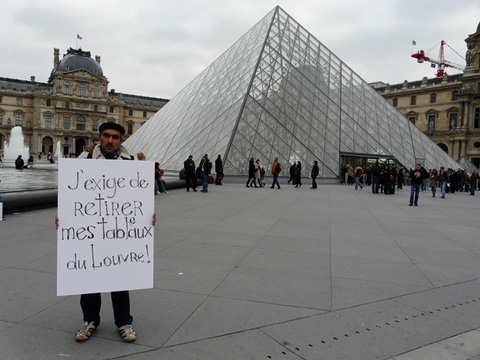10:25 PM XXI Century Russian Avant-Garde by way of the Musee du Louvre | |
LEFT: Advei Ter-Oganyan: "I demand to remove my art from the Louvre!"
The Radical Abstractionism is the series of geometric abstractions with captions from the Russian Criminal Code. The series was created in 2004 by Avdei Ter-Oganyan as an attempt to address the real life situations, when public interpretation of innocuous artwork, detached from the artist's true intentions, turns art into a criminal act and artist into fugitive. Under the circumstances, virtually any artist is in danger of becoming a criminal. Avdey Stepanovich Ter-Oganyan (born 1961, Rostov-on-Don) is Russian-Armenian contemporary artist, who lives and works in Prague, Czech Republic. His work addresses the contingency of the avant-garde gesture in Soviet and post-Soviet social realm. Grekov Art School, School of Contemporary Art, Manezh Performance During soviet times, in 1978-82 studied at Grekov Art School, from which was (twice) expelled for “avant-gardism." In 1987 was among the leaders of Young Rostov Artists Union “Art or Death.” In 1988 moved to Moscow and settled in Trekhprudny squat, where he opened an art gallery with friends in 1991-93. In 1995-98 creates the School of Contemporary Art, producing the whole new generation of artists. Its students including the artist’s son David Ter-Oganyan, Alexey Buldakov and Valery Shtak would later form the Radek Community. In 1998 he made the Young Atheist performance in Moscow Manezh Central Exhibition Hall, in which invited the visitors to smash cheap reproductions of icons. The artist believed that lousy printed religious image glued to a carton board had no celestial presence. The gesture was meant to revive the provocative modernist nihilism and avant-gardist subversion to rise beyond conventional wisdom. Ter-Oganyan was charged for “extremism” according to Article 282 of the Russian Criminal Code. In 2002 he was granted political asylum in Czech Republic. Caution Religion and Radical Abstractionism In 2000s preoccupied with transgression of the language of contemporary art in post-soviet politics and social life. Following several lawsuits against artists and curators for "extremism," in 2004 creates the Radical Abstractionism series. The series was inspired by the art from the exhibit Caution Religion (2003) which went on public trial in 2004. The harmless objects from the show were interpreted in such strong juridical terms that the two curators of the exhibit were charged under the Article 282 "Incitement of Hatred or Enmity, as Well as Abasement of Human Dignity" of the Criminal Code of the Russian Federation (The New York Times). They faced 2 years jail term. According to the artist, "Russian professional artistic community observed in disbelief and despair how nonsensical interpretation of an artwork had a power of placing the two respected art-world figures behind bars." Russia Bans Radical Abstractionism From the Louvre Show The joke was not taken well by the Russian authorities, and was deemed an extremist act: the four pieces from the series were arrested at customs on its way to be exhibited at the Musée du Louvre, Paris in 2010. To avoid tensions with Russia and to keep the exhibition on schedule, the Louvre received digital copies of Ter-Oganyan's work in Paris and printed it out to include in the show. The artist felt that such act undercuts his efforts to reveal the underlying problem, which threatens Russian artistic community and after unsuccessful negotiations with the museum, demanded his art to be removed from the Louvre. He traveled to the opening of the exhibition and stood in front of the museum with the banner "I demand to remove my art from the Louvre!" Oleg Mavromatti and Support From the USA Such a rare demand coming from an artist, generated a substantial media reaction. In turn, Ter-Oganyan used it to attract attention to Russian artist in exile Oleg Mavromatti, who fell victim to the article N282 and was about to be extradited from Bulgaria to face trial in Moscow. It took collective action from several members of the American art world and beyond - including Jeanette Ingberman (director of Exit Art, which reps Mavromatti’s work), art dealer Ronald Feldman, U.S. Senator Kirsten Gillibrand and Mark Rothko's son, Christopher - to bring the matter to a successful resolution. The Radical Abstractionism series was never pardoned by the Russian government, and is perceived a subject to the Article N282: Incitement of Hatred or Enmity, as Well as Abasement of Human Dignity of the Russian Criminal Code. However, Russian artistic community took a stand. The Radical Abstractionism was nominated for the state prize Innovation (2006) and was shown in a number of exhibits, including Russia! (2006) at S. Guggenheim Museum in Bilbao; Russia-2 (2005) during the 1st Moscow Biennale of Contemporary Art; Retrospective (2005) at Stavanger, Norway.
| |
|
| |
| Total comments: 0 | |



